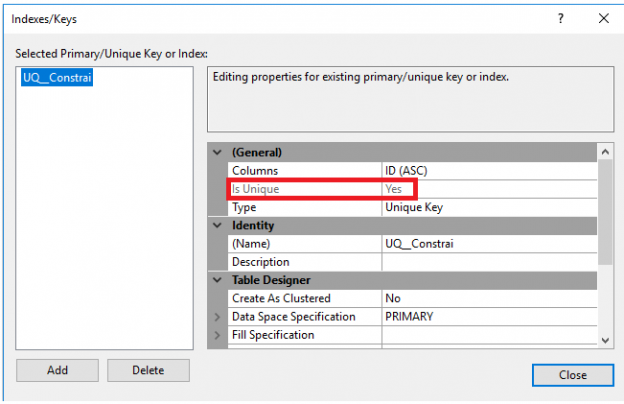Auto Generate Primary Key Sql
Summary: in this tutorial, you will learn how to use SQLite PRIMARY KEY constraint to define a primary key for a table. Introduction to SQLite primary key. A primary key is a column or group of columns used to identify the uniqueness of rows in a table. Each table has one and only one primary key. Summary: in this tutorial, we will show you what the primary key is and how to manage PostgreSQL primary key constraints through SQL statements. A primary key is a column or a group of columns used to identify a row uniquely in a table. You define primary keys through primary key constraints. Summary: in this tutorial, we will show you what the primary key is and how to manage PostgreSQL primary key constraints through SQL statements. A primary key is a column or a group of columns used to identify a row uniquely in a table. You define primary keys through primary key constraints. Primary Key Generation Using Oracle's Sequence. Oracle provides the sequence utility to automatically generate unique primary keys. To use this utility to auto-generate primary keys for a CMP entity bean, you must create a sequence table and use the @AutomaticKeyGeneration annotation to point to this table. The Microsoft JDBC Driver for SQL Server supports the optional JDBC 3.0 APIs to retrieve automatically generated row identifiers. The main value of this feature is to provide a way to make IDENTITY values available to an application that is updating a database table without a requiring a query and a second round-trip to the server. Create Table with Primary Key autoincrement Identity function. To create a table with Primary Key autoincrement you need to use identity function like in the below example. Create Table with Primary Key autoincrement. USE tempdb; GO create table Researchgroups( id int identity not null primary key, name varchar(500) not null).
Summary: in this tutorial, we will show you what the primary key is and how to manage PostgreSQL primary key constraints through SQL statements.
A primary key is a column or a group of columns used to identify a row uniquely in a table.
You define primary keys through primary key constraints. Technically, a primary key constraint is the combination of a not-null constraint and a UNIQUE constraint.
A table can have one and only one primary key. It is a good practice to add a primary key to every table. When you add a primary key to a table, PostgreSQL creates a unique B-tree index on the column or a group of columns used to define the primary key.
Define primary key when creating the table
Auto Generate Primary Key Sql Plus
Normally, we add the primary key to a table when we define the table’s structure using CREATE TABLE statement.
The following statement creates a purchase order (PO) header table with the name po_headers.
The po_no is the primary key of the po_headers table, which uniquely identifies purchase order in the po_headers table.
In case the primary key consists of two or more columns, you define the primary key constraint as follows:
For example, the following statement creates the purchase order line items table whose primary key is a combination of purchase order number ( po_no) and line item number ( item_no).
If you don’t specify explicitly the name for primary key constraint, PostgreSQL will assign a default name to the primary key constraint. By default, PostgreSQL uses table-name_pkey as the default name for the primary key constraint. In this example, PostgreSQL creates the primary key constraint with the name po_items_pkey for the po_items table.
In case you want to specify the name of the primary key constraint, you use CONSTRAINT clause as follows:
Define primary key when changing the existing table structure
It is rare to define a primary key for existing table. In case you have to do it, you can use the ALTER TABLE statement to add a primary key constraint.
The following statement creates a table named products without defining any primary key.

Suppose you want to add a primary key constraint to the products table, you can execute the following statement:
How to add an auto-incremented primary key to an existing table
Suppose, we have a vendors table that does not have any primary key.
And we add few rows to the vendors table using INSERT statement:
To verify the insert operation, we query data from the vendors table using the following SELECT statement:
Now, if we want to add a primary key named id into the vendors table and the id field is auto-incremented by one, we use the following statement:
Let’s check the vendors table again.
Remove primary key
To remove an existing primary key constraint, you also use the ALTER TABLE statement with the following syntax:
Auto Generate Primary Key Sql Code
For example, to remove the primary key constraint of the products table, you use the following statement:
In this tutorial, you have learned how to add and remove primary key constraints using CREATE TABLE and ALTER TABLE statements.
- SQL Tutorial
- Advanced SQL
Auto Increment Mysql
- SQL Useful Resources
- Selected Reading
A primary key is a field in a table which uniquely identifies each row/record in a database table. Primary keys must contain unique values. A primary key column cannot have NULL values.
A table can have only one primary key, which may consist of single or multiple fields. When multiple fields are used as a primary key, they are called a composite key.
If a table has a primary key defined on any field(s), then you cannot have two records having the same value of that field(s).
Note − You would use these concepts while creating database tables.
Auto Increment Primary Key Sqlite
Create Primary Key
Here is the syntax to define the ID attribute as a primary key in a CUSTOMERS table.
To create a PRIMARY KEY constraint on the 'ID' column when the CUSTOMERS table already exists, use the following SQL syntax −
NOTE − If you use the ALTER TABLE statement to add a primary key, the primary key column(s) should have already been declared to not contain NULL values (when the table was first created).
For defining a PRIMARY KEY constraint on multiple columns, use the SQL syntax given below.
To create a PRIMARY KEY constraint on the 'ID' and 'NAMES' columns when CUSTOMERS table already exists, use the following SQL syntax.

Delete Primary Key
/the-sims-4-vampires-cd-key-generator.html. You can clear the primary key constraints from the table with the syntax given below.